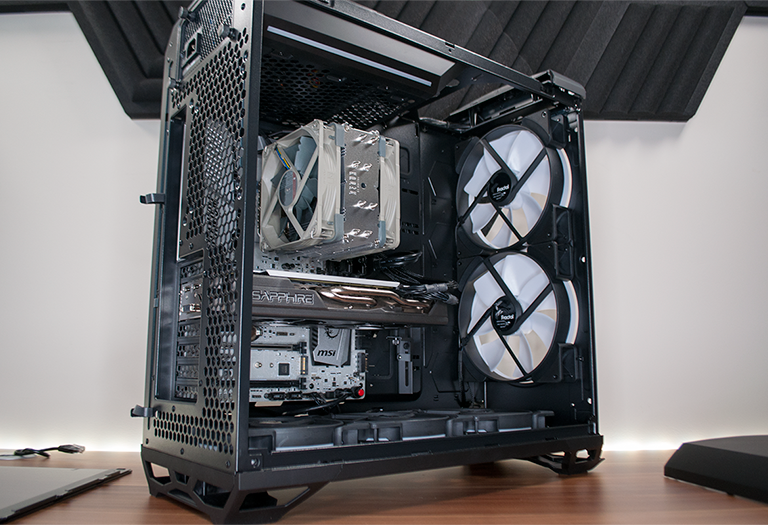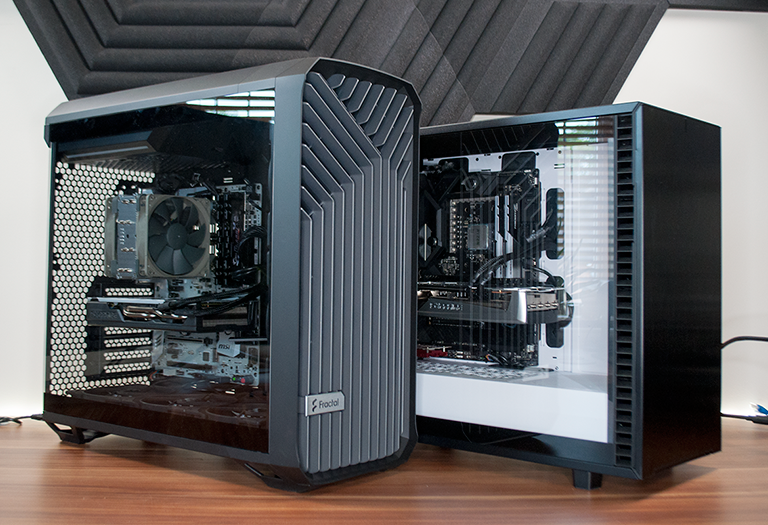Build Considerations
Torrent is designed with high-performance builds in mind, yet installing a thick rad to the floor could well foul some of the headers on the bottom edge of a regular ATX board. A dual 180 radiator up front seems the optimal route, and if you do decide to go water-cooled, you'll find dedicated mounting points alongside the motherboard for a reservoir, as well as 21mm and 25.4mm fill ports beneath the top panel. Both the front and bottom are also lined with full-length nylon filters, though you will need to remove the front panel to get access to either.
The build process is different enough to be interesting, and while installing our AMD Ryzen test platform it became clear that certain elements work better than others. Starting with the various plus points, the bottom-hinged and top-latched side panels provide the same tool-free experience that we've come to appreciate on recent Fractal enclosures, and the top I/O panel is logically stocked with a pair of audio jacks, two USB 3.1 Gen 1 Type-A, one USB 3.1 Gen 2 Type-C, a backlit power button and a small reset button.
Fractal helpfully integrates a SATA-powered Nexus 9P Slim PWM fan hub, ensuring all chassis fans can be controlled via a single motherboard header, and there's also a GPU support bracket included in the box to help guard against any unwanted sag. Should you favour a vertical graphics card, you'll need to stump up the cash for an optional Flex-B20 riser bracket.
Hardware support is ample with room for up to an E-ATX motherboard, 423mm GPU clearance, 230mm PSU clearance, 188mm for CPU cooler height, seven bridgeless expansion slots, and six dedicated storage bays; four 2.5in trays for SSDs and two 3.5in for HDDs, all attached to the back of the motherboard tray. A ceiling-mounted PSU might have been awkward but installation is simple enough with the top panel removed. There are internal Velcro ties to help route cables throughout the chassis, and on the outside there's a series of smaller Velcro ties that can be used to tie all the connected cables in a streamlined column.
Goes without saying that RGB lighting is a key feature for the £200 model. An RGB strip is integrated in the bottom edge of the PSU bay, you'll find recessed 300mm channels on the flanks of the underside to add optional LED strips, yet while the colourful fans look pretty, cabling can become messy as a result of all the illumination. The five pre-installed blowers are designed to be daisy-chained to one 5V motherboard header, but two cables per fan (one PWM, one RGB) results in a whole lot of clutter.
Keeping things tidy with 32mm of clearance around back is easier said than done - we gave up, as you can see - and note that the RGB version of the chassis has tempered glass panels on both sides, so you will want to tie everything down neatly to create a tidy finish and prevent the side panel from pinging open inadvertently. Said panels can be secured using screws during transport.
RGB cable clutter is without a doubt our biggest gripe, but there are a couple of other minor niggles to be aware of. An emphasis on maximum airflow means little in the way of sound-proofing - Torrent naturally isn't going to be as silence-optimised as Define 7 - and though officially a mid-tower solution, it is a little on the large side. Those extra 55mm in height vs. the Define don't go unnoticed, and as someone who prefers a more petite tower, here's hoping a Torrent Compact is in the pipeline.
How about real-world performance? Installing our customary AMD test platform wasn't entirely straightforward. Our Ryzen 7 1800X CPU is typically cooled by a 240mm Fractal Design Celsius S24, but where would you install said radiator? There's no space up top and it hardly makes sense to remove the default 180mm front or 140mm bottom fans. That being the case, we opted to swap the liquid cooler for a Noctua NH-U12S redux. All-core temp remained steady at 60°C and the accompanying Sapphire Radeon RX 580 graphics card reached 71°C when gaming. Excellent numbers on both fronts, and despite the absence of sound-proofing, noise levels remained comfortable as a result of large fans that don't need to spin quite so fast.












